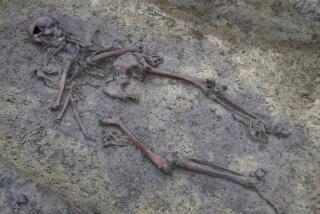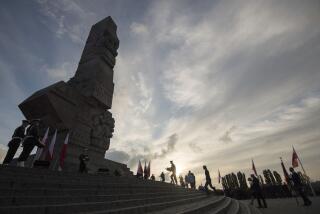Digging for Truth in Sarajevo
SARAJEVO, Bosnia-Herzegovina — Ethnic hatred is never far from the surface in Bosnia, so it takes a lot to get former enemies to work together--as in searching for a mass grave.
For the first time since Bosnia-Herzegovina’s war ended in 1995, Serbs, Muslims and at least one Croat came together Thursday at a graveyard in the capital, Sarajevo, with the gruesome task of digging up bodies.
Serbs claim that Sarajevo’s mainly Muslim defenders dumped as many as 60 Serbian corpses into a pit on the edge of a large cemetery and then tried to cover it up with neat rows of individual graves.
The accusation of Muslim atrocities in the very capital that Serbian forces tried to strangle with a nearly four-year siege--during which thousands were killed by shells and snipers--is offensive to Sarajevo’s survivors. A few of those survivors taunted the gravediggers from the other side of a low metal fence guarded by Bosnian police and Italian troops serving as NATO-led peacekeepers.
By the rules of the peace accord reached in Dayton, Ohio, that ended the war, three ethnically based commissions searching for more than 20,000 missing people have the right to search wherever the evidence leads. However, the Muslims’ letting Serbs dig for the truth in a cemetery that symbolizes Sarajevo’s suffering may have nudged Bosnia a little closer to burying its vicious past.
Diplomat Thanks Bosnian Parties
Carlos Westendorp, the Spanish diplomat who oversees Bosnia, thanked Bosnian Muslims, Serbs and Croats for putting aside “political quarreling and squabbling for a greater humanitarian purpose.”
The forensic team came to Sarajevo from the Serbian republic, which controls 49% of Bosnia and is still enemy territory in the eyes of many Bosnian Muslims and Croats.
The Serbian republic rarely cooperates with the Muslim-Croat Federation, and only then under pressure from foreign officials such as Westendorp, who runs Bosnia much like a protectorate.
Foreign officials delayed the Serbian dig in Sarajevo’s Lion Cemetery for as long as possible to let tempers cool before allowing Serbs to tread on graves filled with thousands of their countrymen’s victims.
However, as soon as the Serbs arrived, the anger built and arguments broke out.
Jovo Rosic, head of the Serbian commission for missing persons, wanted to start by digging up the graves of newborn children.
A witness who led the Serbs to the site insists that the bodies are hidden under more than 130 grave markers cut from wooden planks, which named babies who died in the first year of the war.
“Don’t remove these poor children,” Vlado Raguz, the cemetery’s Bosnian Croat director, pleaded with Rosic. “Don’t be so stupid. Don’t do these things.”
“You are only covering the traces of your crimes,” Rosic shot back.
Serbs Vow to Keep Digging for Answers
However, the Serbs relented and began instead with a site beside the babies’ graves, where Raguz insisted adult bodies that were not claimed by relatives are buried.
“We are not going to give up,” Rosic said in an interview. “We are going to gather more data, and if what we believe is confirmed, with the agreement of the Bosnian side, we will continue.”
When the Serbs took shovels and pickaxes to the snow-covered earth a few yards away, the cemetery’s director watched and shook his head in disgust.
He taunted the gravediggers with the name of Dr. Jovo Raskovic, a former leader of the Croatian Serbs and a psychiatrist who once questioned his people’s sanity. The Serbs told him to shut up.
“It’s their problem why they came,” Raguz said as they shouted back at him. “I don’t know what it will cause, but what they came here to get, they could properly get from us with documents for every single grave site.
“They claim there are bodies under these bodies. They can dig. What they are saying is nonsense. Nothing like this exists.”
However, several Bosnian Muslims living in the area say they remember seeing bodies dumped down ramps from trucks at the same spot, said Agneta Johansson, Westendorp’s coordinator of exhumations.
“So there is something behind it,” she said in an interview at the cemetery. “But these people would never, ever dare to come forward and say something. It’s not my job to do so either.”
In their first day of digging Thursday, the Serbs found the remains of 10 bodies in shallow, unmarked graves on the top edge of Lion Cemetery, Westendorp’s office confirmed.
Less than half a yard deep, the diggers found a human skull partially wrapped in a blue blanket. A large bone lay beside it.
From a quick look at the remains, Dr. Zeljko Koran, the Serbian team’s forensic expert, concluded that it was the skeleton of an elderly female. Beyond that, it was impossible to say anything certain until lab tests are completed, Koran said.
“We’ll see whether there are more layers [of bodies] underneath, because nothing is impossible,” he added.
Serbs Claim Two More Mass Graves in Capital
Finding a skeleton so close to the surface in a cemetery is hardly unusual in Bosnia, Koran said.
Wartime funerals often were rushed because mourners were afraid of coming under fire.
The Serbs have identified at least two other sites in Sarajevo where they claim are mass graves. That search will likely have to wait until spring, when the ground thaws.
Whatever skeletal remains the Serbs unearth in Lion Cemetery will be cleaned and shipped to Republika Srpska, where the commission’s forensic experts expect to spend weeks analyzing them.
Their first priority is to identify the victims and let relatives know what happened to their loved ones. They also can report any evidence of war crimes to the International Criminal Tribunal for the Former Yugoslavia at The Hague.
Estimates Put Number Missing at 30,000
A representative of the tribunal is monitoring the Sarajevo exhumations to see if there is any evidence worth further investigation.
Between 80% and 90% of the 20,000 people reported missing since the war’s end are men of Muslim origin, Manfred Nowak, formerly the United Nations expert on disappearances in the former Yugoslavia, reported in 1996.
“While all Bosnian parties caused disappearances, there is no doubt that the Bosnian Serb forces and their allies, the Yugoslav National Army and Serb paramilitary forces, are responsible for more than 80% of all disappearances,” Nowak wrote.
Amor Masovic, head of the Bosnian Muslim commission on disappearances, estimates the total number of missing on all sides of the war at closer to 30,000 people, and about 3,500 of their bodies have been found in unmarked graves so far, he said.
“Some of them were killed in the most monstrous way,” Masovic said.
“There were classic executions of 10 or so civilians, or prisoners, in front of firing squads.
“Others were beaten until they died. We have examples of a victim killed with a harpoon for underwater fishing, or another suffocated by stuffing her head in a bucket of white paint.”
The youngest victim Masovic has found was 17 days old when he died. The oldest was 102 years old. More than 10% of the bodies were women.
“In two or three days, I will start an exhumation at a cave in Sanski Most that is about [44 yards] deep,” he said. “It hides the mortal remains of probably 150 prisoners that were taken one night from a camp in two buses and trucks in an unknown direction.
“After 6 1/2 years of searching, it seems we are about to find out what their fate was by discovering that cave.”
More to Read
Sign up for Essential California
The most important California stories and recommendations in your inbox every morning.
You may occasionally receive promotional content from the Los Angeles Times.










